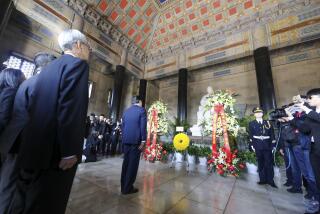Death illuminates niche of Mao life
- Share via
BEIJING — The death Friday of the last known surviving son of Mao Tse-tung cast light on the nearly forgotten children of the man who once reigned as a demigod over a quarter of the world’s population.
Mao’s second son, Anqing, died at 84 after a lifetime in which he had little contact with his famous father and struggled with mental illness, according to state media.
The private lives of Chinese leaders are rarely considered public information. The fates of Mao Tse-tung’s children have been especially shrouded.
Mao, who led the Chinese Communist Party to power in the 1940s and ruled China until his death in 1976, acknowledged having 10 children. Six either died in infancy or were abandoned during the long civil war between his forces and China’s Nationalist government. Two are known to be alive, daughters Li Min and Li Na.
Mao’s eldest son, Anying, who some historians believe could have been groomed as an heir, died in action during the Korean War at 28. His story is well known in China.
Anqing lived in relative obscurity. He and his elder brother spent their early lives in Shanghai, where their mother -- Mao’s second wife, Yang Kaihui -- was a communist activist. The sons sold newspapers and scavenged garbage to help support themselves, according to state media. Anqing is said to have suffered head trauma as a youth in a beating by Shanghai police.
After their mother was executed by the Nationalists, the two boys were smuggled by the Communist Party to the Soviet Union, where they spent about a decade. Their younger brother, Anlong, died as a child.
The boys never saw much of their father. In a tribute on the 30th anniversary of the leader’s death last year, Mao Anqing said his father opposed special treatment for relatives. Instead of giving his sons cushy jobs in the city upon their return from studying abroad, Mao sent both to work in the countryside, the son said.
Mao Anqing was fluent in Russian and translated books on Marxist-Leninist ideology, according to state media coverage of his death, which offered few details about his mental illness and the years he spent in hospitals in Beijing and Dalian.
At 37, he married his sister-in-law Shao Hua. Ten years later they had a son, Xinyu, who is the father of Mao Tse-tung’s only known great-grandson, Dong Dong, born on the same day as his great-grandfather, 110 years later.
Mao Tse-tung’s two remaining children live largely outside the public eye, much as their half brother did.
Li Min was one of six children born to Mao’s third wife, He Zizhen. Four of the children reportedly were given to peasants as Mao’s forces fled Nationalist troops during the Communists’ Long March in 1935. One baby died in the Soviet Union, where He had sought medical treatment.
Li Min suffered later under Mao’s jealous fourth wife, Jiang Qing, the mother of Li Na. For a while Mao tried to groom Li Na as a possible successor, but that effort did not get far, said Ye Yonglie, a Mao biographer.
“As Mao’s influence wanes, his name is mentioned less and less in official media,” Ye said. “His children, of course, merit even less mentioning. They represent Mao and a bygone era.”
*
More to Read
Sign up for Essential California
The most important California stories and recommendations in your inbox every morning.
You may occasionally receive promotional content from the Los Angeles Times.








